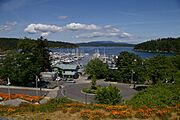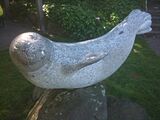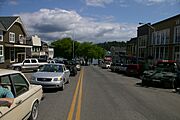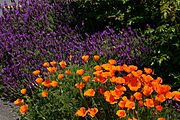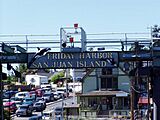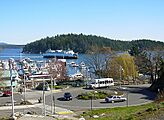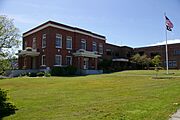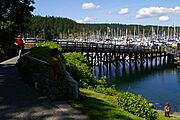Friday Harbor, Washington facts for kids
Quick facts for kids
Friday Harbor
|
|
|---|---|
| Friday Harbor, Washington | |
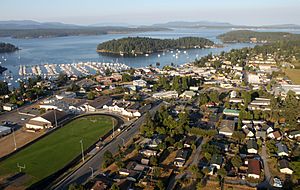
Friday Harbor, Washington
|
|
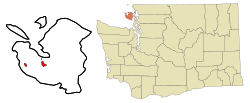
Location of Friday Harbor, Washington
|
|
| Country | United States |
| State | Washington |
| County | San Juan |
| Incorporated | February 10, 1909 |
| Area | |
| • Total | 2.25 sq mi (5.84 km2) |
| • Land | 2.18 sq mi (5.65 km2) |
| • Water | 0.07 sq mi (0.18 km2) |
| Elevation | 56 ft (17 m) |
| Population
(2020)
|
|
| • Total | 2,613 |
| • Density | 1,161.3/sq mi (447.4/km2) |
| Time zone | UTC−8 (Pacific (PST)) |
| • Summer (DST) | UTC−7 (PDT) |
| ZIP Code |
98250
|
| Area codes | 360 and 564 |
| FIPS code | 53-25615 |
| GNIS feature ID | 1505051 |
Friday Harbor is a small town in Washington State, United States. It is located in San Juan County. In 2020, about 2,613 people lived there.
Friday Harbor is on San Juan Island. It is the main business center for all the San Juan Islands. It is also the county seat, which means it's where the local government for San Juan County is located.
Contents
History of Friday Harbor
Early Days and Naming
In 1845, the Hudson's Bay Company claimed San Juan Island. They built a salmon curing station there in 1850. A few years later, they started a sheep farm.
The town gets its name from Joseph Poalie Friday. He was a native Hawaiian who worked at a place called Fort Cowlitz. Later, he moved to San Juan Island. He raised and herded sheep near the harbor.
Becoming a County Seat
After a peaceful agreement called the Pig War, the San Juan Islands became their own county in 1873. Friday Harbor was chosen as the county seat. The town officially became a city on February 10, 1909. It is still the only official town in the San Juan Islands.
Trade and Growth
In the past, sailing ships and steamships often visited Friday Harbor. They carried people, mail, and goods. The island sent out products like apples, pears, strawberries, and salmon.
Over time, things changed. The Great Depression and World War II affected trade. New farming methods and competition also made old industries less important. But in the 1970s, new businesses grew. These included tourism, real estate, and construction. Today, Friday Harbor is a busy and successful town once again.
Scientific Discovery
A scientist named Osamu Shimomura collected jellyfish from the docks in Friday Harbor. He found special proteins in them that glow green under blue light. One of these, called green fluorescent protein, is now used all over the world in science. It helps scientists see what's happening inside cells.
Geography and Climate
Friday Harbor is on the east side of San Juan Island. It faces the San Juan Channel. The town covers about 2.16 square miles (5.6 square kilometers). Most of this is land, with a small amount of water.
The town has a Mediterranean climate. This means it has warm, dry summers. The winters are cold and rainy, but not usually very harsh.
| Climate data for Friday Harbor, Washington (Friday Harbor Airport), 1991–2020 normals, extremes 1998–present | |||||||||||||
|---|---|---|---|---|---|---|---|---|---|---|---|---|---|
| Month | Jan | Feb | Mar | Apr | May | Jun | Jul | Aug | Sep | Oct | Nov | Dec | Year |
| Record high °F (°C) | 60 (16) |
59 (15) |
71 (22) |
79 (26) |
98 (37) |
101 (38) |
97 (36) |
93 (34) |
89 (32) |
76 (24) |
66 (19) |
58 (14) |
101 (38) |
| Mean maximum °F (°C) | 53.9 (12.2) |
54.9 (12.7) |
61.7 (16.5) |
68.0 (20.0) |
76.1 (24.5) |
80.9 (27.2) |
86.3 (30.2) |
85.2 (29.6) |
80.3 (26.8) |
66.5 (19.2) |
59.6 (15.3) |
53.9 (12.2) |
89.3 (31.8) |
| Mean daily maximum °F (°C) | 47.1 (8.4) |
48.5 (9.2) |
52.6 (11.4) |
57.4 (14.1) |
63.7 (17.6) |
68.4 (20.2) |
72.4 (22.4) |
73.3 (22.9) |
68.1 (20.1) |
58.5 (14.7) |
51.0 (10.6) |
46.3 (7.9) |
58.9 (15.0) |
| Daily mean °F (°C) | 42.1 (5.6) |
42.5 (5.8) |
45.5 (7.5) |
49.1 (9.5) |
54.0 (12.2) |
58.2 (14.6) |
61.2 (16.2) |
61.6 (16.4) |
58.0 (14.4) |
51.2 (10.7) |
45.4 (7.4) |
41.6 (5.3) |
50.9 (10.5) |
| Mean daily minimum °F (°C) | 37.1 (2.8) |
36.5 (2.5) |
38.4 (3.6) |
40.7 (4.8) |
44.3 (6.8) |
48.1 (8.9) |
50.0 (10.0) |
50.0 (10.0) |
47.9 (8.8) |
44.0 (6.7) |
39.8 (4.3) |
36.8 (2.7) |
42.8 (6.0) |
| Mean minimum °F (°C) | 24.2 (−4.3) |
25.3 (−3.7) |
27.9 (−2.3) |
32.3 (0.2) |
36.0 (2.2) |
41.0 (5.0) |
44.2 (6.8) |
44.6 (7.0) |
41.2 (5.1) |
33.7 (0.9) |
26.3 (−3.2) |
22.9 (−5.1) |
18.1 (−7.7) |
| Record low °F (°C) | 11 (−12) |
17 (−8) |
19 (−7) |
27 (−3) |
30 (−1) |
36 (2) |
40 (4) |
42 (6) |
36 (2) |
26 (−3) |
12 (−11) |
8 (−13) |
8 (−13) |
| Average precipitation inches (mm) | 2.69 (68) |
1.54 (39) |
1.35 (34) |
1.01 (26) |
1.14 (29) |
0.75 (19) |
0.48 (12) |
0.70 (18) |
1.04 (26) |
2.34 (59) |
2.98 (76) |
2.45 (62) |
18.47 (468) |
| Average precipitation days (≥ 0.01 in) | 16.7 | 13.8 | 14.3 | 10.3 | 9.6 | 7.5 | 5.0 | 7.7 | 11.8 | 15.2 | 16.3 | 15.9 | 144.1 |
| Source 1: NOAA | |||||||||||||
| Source 2: National Weather Service (mean maxima/minima 2006–2020) | |||||||||||||
Population of Friday Harbor
| Historical population | |||
|---|---|---|---|
| Census | Pop. | %± | |
| 1910 | 400 | — | |
| 1920 | 522 | 30.5% | |
| 1930 | 601 | 15.1% | |
| 1940 | 658 | 9.5% | |
| 1950 | 783 | 19.0% | |
| 1960 | 706 | −9.8% | |
| 1970 | 803 | 13.7% | |
| 1980 | 1,200 | 49.4% | |
| 1990 | 1,492 | 24.3% | |
| 2000 | 1,989 | 33.3% | |
| 2010 | 2,162 | 8.7% | |
| 2020 | 2,613 | 20.9% | |
| U.S. Decennial Census 2020 Census |
|||
How Many People Live Here?
In 2010, there were 2,162 people living in Friday Harbor. There were 1,015 households, which are groups of people living together. About 27% of these households had children under 18.
The average age of people in Friday Harbor was about 41 years old. Around 22% of residents were under 18. About 17% were 65 years or older.
Arts and Culture
Friday Harbor was once the main base for the Sea Shepherd Conservation Society. This group works to protect ocean wildlife. Its founder, Paul Watson, lived there.
Getting Around Friday Harbor
Ferry Services
The main way to get to Friday Harbor from the mainland is by ferry. Washington State Ferries runs boats between Friday Harbor and Anacortes several times a day.
There used to be a ferry that went to Sidney, British Columbia, in Canada. But this service stopped in 2020. It is not expected to start again until at least 2030. You can also find private passenger ferries from other cities like Bellingham and Seattle.
Local Transportation
Once you are on San Juan Island, you can find taxis. There are also seasonal shuttles, bicycles, and mopeds for rent. The San Juan Transit system helps people get around the island all year. It connects Friday Harbor to other popular spots.
Air Travel
The Friday Harbor Airport offers some airline services. You can also take a floatplane from the midtown Friday Harbor Seaplane Base. These planes fly to Seattle's Lake Union or Renton Municipal Airport.
Education
Friday Harbor is home to the famous Friday Harbor Laboratories. This is a marine biology research center for the University of Washington.
The town has several schools for kids. These include Friday Harbor High School, Friday Harbor Middle School, and Friday Harbor Elementary School. They are all part of the San Juan Island School District. There are also private schools like Stillpoint School and Spring Street International School. A branch of Skagit Valley College is also on the island.
Sister Cities
Friday Harbor has special connections with other towns around the world. These are called sister cities:
 Terschelling, Netherlands
Terschelling, Netherlands Vela Luka, Croatia (This is also a sister city with Anacortes)
Vela Luka, Croatia (This is also a sister city with Anacortes)
Gallery
-
A statue of a seal named Popeye in Fairweather Park
-
Friday Harbor's landscaping is rich with lavender and California poppies.
-
Cars at the entrance to the ferry terminal
Images for kids
See also
 In Spanish: Friday Harbor (Washington) para niños
In Spanish: Friday Harbor (Washington) para niños


